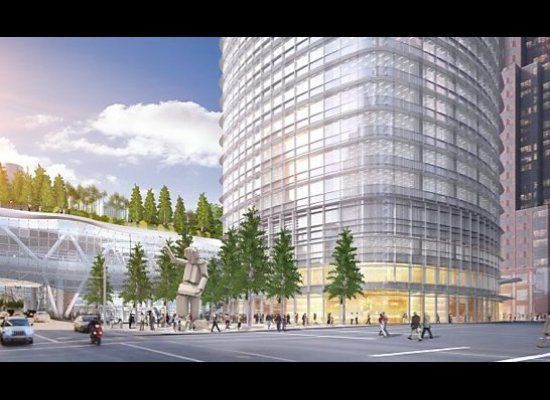
The general concept behind the entire Transbay Terminal project is one of immense scale.
The northern terminus of the country's first high-speed rail system will be a train station called the "Grand Central Terminal of the West," nestled right next to the tallest building in all of Northern California.
It's an ambitious project, to be sure, and is one that has the potential to completely transform a wide swath of San Francisco. However, the impressive new designs for the Transbay Tower released earlier this week can't help but raise new questions about the overall viability of the project--both in occupancy of the tower and how the terminal itself will hook into the transportation grid of California as a whole.
(SCROLL DOWN FOR PHOTOS)
Development firm Hines recently submitted updated designs for the tower, which were detailed in an article by San Francisco Chronicle design critic John King on Tuesday. While the new plans are noticeably scaled back from the original 1,200-foot-tall specs, the 60-story Pelli Clarke Pelli-designed edifice will still easily beat San Francisco's current height champ, the Transamerica Pyramid.
The Transbay Tower will be about 50 feet shorter than the U.S. Bank Tower, which is currently the tallest building on the West Coast.
The building's obelisk shape, which San Francisco Bay Guardian editor Tim Redmond called a "giant penis in the sky," consists of a lattice of reflective glass and a web of metal that bends in near the top for a hollow aesthetic flourish.
Removing habitable space from the building's crown is a new aspect of the design, a deliberate move to shrink the tower's considerable shadow, which was initially projected to stretch all the way past the northern edge of the Financial District and darken parks in Chinatown and North Beach.
1984's voter-approved Proposition K requires any new building casting shadows over a city park first gain approval from both the Planning and Rec & Parks commissions.
One of the tower's most notable features is its huge amount of office space. The high-rise will offer 1.35 million square feet of space for rent. "San Francisco is ready for more office space," Paul Paradis of Hines told the Chronicle, "so we want to advance as soon as possible."
Commercial office space is at a premium in San Francisco, especially in the South of Market neighborhood, where the tower will be located. A social media-fueled technology boom has expanded the largely Silicon Valley-based tech sector north into San Francisco's SoMa district, leading the once-industrial area to become quite possibly the single hottest real estate market in the entire country with rents rocketing into the stratosphere.
However, not everyone is so bullish on SoMa over the long term. "As an appraiser, any time you see excessive growth, it just makes you nervous," Mark Linne, executive vice president of the real estate valuation services company Appraisal World, told The Huffington Post.
Some people have worried that the rapid increase in both demand and prices in the area could be the symptoms of a bubble being inflated.
If what's going on truly is a bubble, coming out with over a million square feet of office space could be problematic; however, as long as demand holds up, it's more likely to be a license to print money.
A large portion of that money would go from the developer straight to the Transbay Joint Powers Authority, which will use it towards the construction of Transbay Terminal transit center. (Although the exact amount the tower's developers will have to pay the authority for the site was recently reduced from $235 million to $185 million.)
Precisely how that terminal will connect into the state's high speed rail system is still up in the air.
Following a shake-up of the High Speed Rail Authority's top brass last month, officials at the troubled project announced a plan to partner with regional rail system Caltrain to share tracks between San Francisco and San Jose.
The plan addressed a number of objections a lot people had with the project by significantly reducing high speed rail's projected cost, avoiding the new construction of rail lines though affluent Silicon Valley neighborhoods and pushing up the time-frame for when high speed trains will run up and down the densely populated urban corridor instead of only traveling between relatively low-population cities in the Central Valley.
"We think the blended approach makes sense on a number of fronts," High Speed Rail Director of Communications Lance Simmens told The Huffington Post. "The governor has been taking about making something that does its ultimate goal of uniting northern and southern California better, faster and cheaper."
The joint-use system would also be a win-win for Caltrain, which would finally be able to get funding for a $1.5 billion electrification of its system serving to increase the speed of its own trains. "Electrification has been in the pipeline for a very long time," Caltrain spokesperson Catherine Dunn told HuffPost. "Almost 100 years."
The problem with all this? The current plan differs considerably from what the high speed rail system was initially supposed to look like. It would probably no longer be a one-seat ride for most commuters; instead, the majority of bullet trains coming up from Southern California would stop at San Jose, and passengers would be forced to switch vehicles to make it all the way up to San Francisco. Even with full electrification, Caltrain can only handle six of its own vehicles and and two high speed trains every hour.
The other issue is that Caltrain's endpoint in San Francisco is a station near the intersection of 4th and King streets and not the Transbay Terminal.
While Caltrain officials have long hoped to have their system extended into the transit hub, written into the voter-approved bond measure that provided High Speed Rail's initial funding was a provision that the line terminate at the Transbay Terminal. Anything that doesn't make it all the way to the terminal has a chance of being ruled illegal. Whether the current plan passes muster is currently being evaluated by California Attorney General Kamala Harris.
If Harris rejects the joint-use system, then the High Speed Rail Authority will likely be forced to go back to its initial, and increasingly unpopular, original designs.
Check out this slideshow of pictures of the Tranbay Terminal and Tower:

